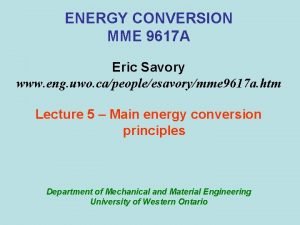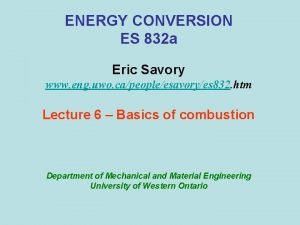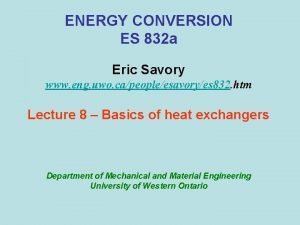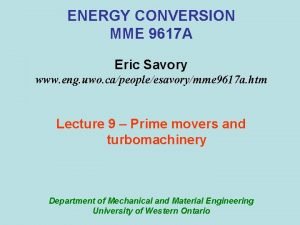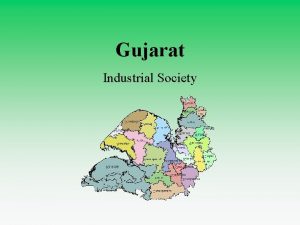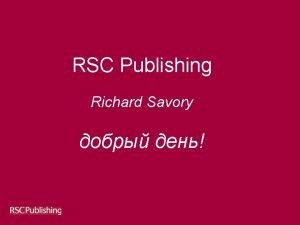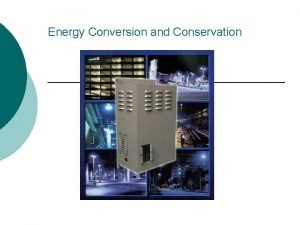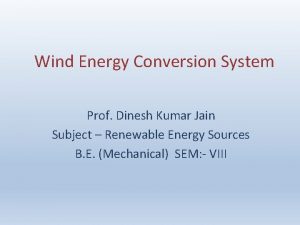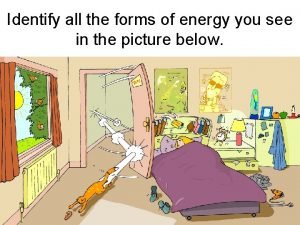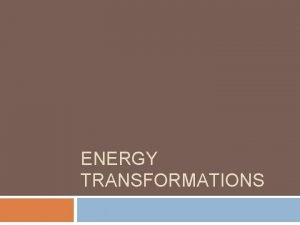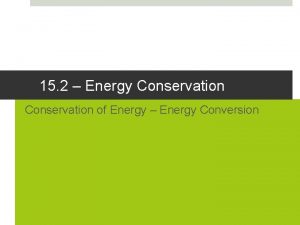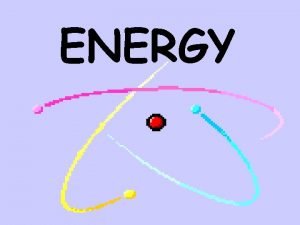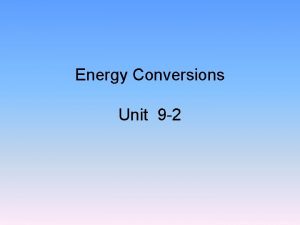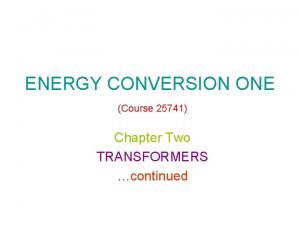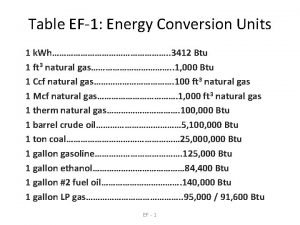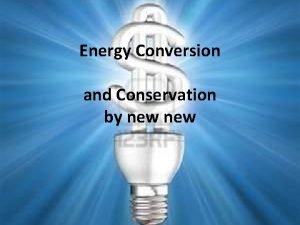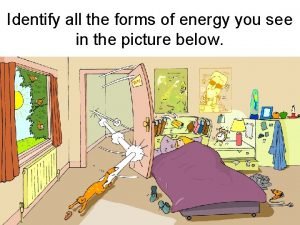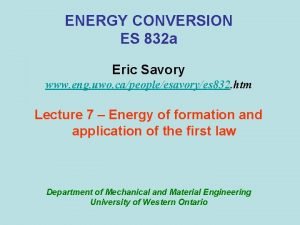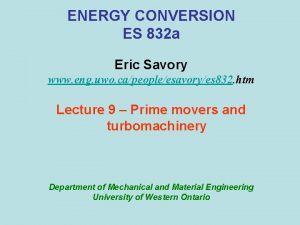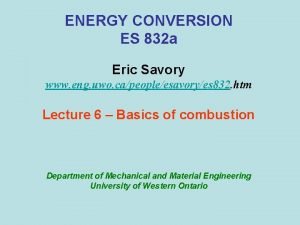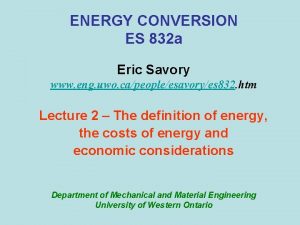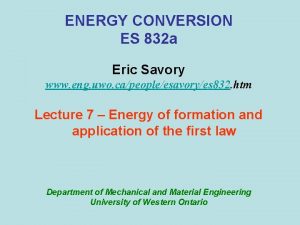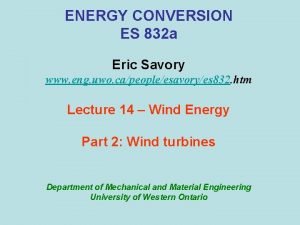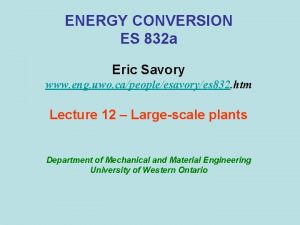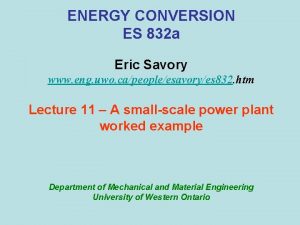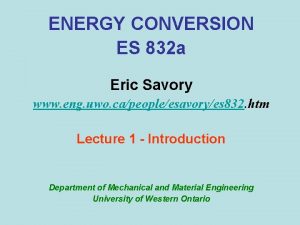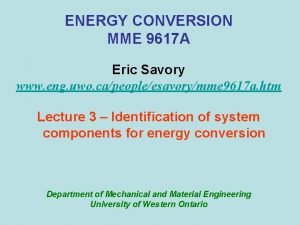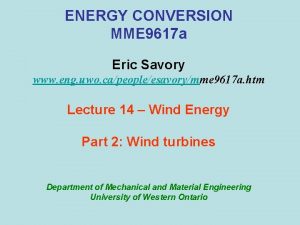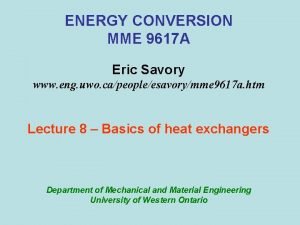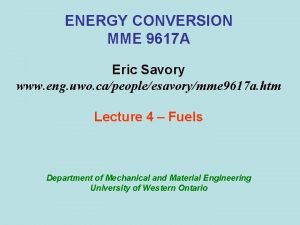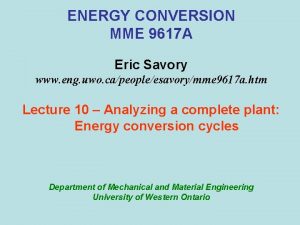ENERGY CONVERSION ES 832 a Eric Savory www






















- Slides: 22

ENERGY CONVERSION ES 832 a Eric Savory www. eng. uwo. ca/people/esavory/es 832. htm Lecture 10 – Analyzing a complete plant: Energy conversion cycles Department of Mechanical and Material Engineering University of Western Ontario

Motivation: Having reviewed the essential basics, we can now apply our knowledge to more practical situations where the energy conversion components are applied to extract useful work. Typical Objectives: 1) Evaluation of Overall Plant Performance (thermal efficiency). 2) Assessment of Large vs. Small–Scale plant requirements. 3) Ancillary considerations - efficiency vs. cost. - environmental criteria.

Strategy: 1. Consider a small-scale plant. Look at different components in “real” sense. Consider overall efficiency. 2. Consider a large-scale plant. Extend principles for small-scale to largescale plants. 3. Comparison of technical and non-technical criteria for scale.

SELECTION CRITERIA: (Driving factors): SMALL-SCALE: (< 300 MW) Drivers: Versatility, compactness, rapid payback, low maintenance. Usually for small loads or where transportability is important. Often these driving factors outweigh efficiency, environmental or other economic factors. Examples: aircraft engines, car engines LARGE-SCALE: (> 500 MW) Drivers: Long-term profitability, large power output, efficiency. Examples: Utilities, petro-chemical processes, smelters NOTES: Environmental concerns are only incidental to efficiency!! Many industrial applications (e. g. large manufacturing facilities, large buildings) are between these two needs and a careful comparison of needs and drawbacks must be considered.

Typical energy flow diagram

Basic gas cycle component analysis Focus: A typical small scale plant (< 300 MW), based on a gas turbine, will be investigated. The interaction of the different components, which have been previously looked at individually will be reviewed by you working through an example of a complete process cycle.

Objectives: 1) Review the characteristic “numbers” for turbomachinery. 2) Review of basic compressor and turbine characteristics.

(1) Characteristic numbers for turbomachines: Turbomachines obey hydrodynamic similarity principles so that their performance can be characterized in terms of dimensionless coefficients. The principal dimensionless parameters for compressors and turbines are:

For incompressible flow (that is for pressure ratios less than 1. 3): D = Outer diameter (m) = rotational speed (e. g. rev/sec) Q = flow rate (m 3/s) P = total pressure difference between inlet and outlet = fluid density

For compressible flow (pressure ratios greater than 1. 3):

The above relationships are valid for scaling geometrically similar turbomachines. However, the losses depend on parameters which scale differently, thus the efficiency for real machines will scale differently. A good rule-of-thumb relationship is provided by (note m defines the model scale):

2) Basic review of Compressors and Turbines: Axial compressors - higher mass flow rate larger space requirement - low P 2/P 1 - high efficiency (> 90%)

Radial or centrifugal - lower mass - compact - high P 2 / P 1 - lower efficiency (75% - 92%) For a turbine, the flow direction is reversed for the radial design. For the axial design, the blade angles are reversed.

Typical h – s diagram ws = ideal (isentropic) specific work (J/kg) wa = actual specific work (J/kg)

The isentropic efficiency (neglecting the change in K. E. ) would, thus, be defined as: For an ideal gas, we then obtain, using h = Cp T:

The compression ratio would then be given by : Where: = k = Cp /Cv T 02 s , T 01 are the total temperatures P 02 , P 01 are the total pressures T 2 s , T 1 are the static temperatures P 2, P 1 are the static pressures

Some additional considerations: Rotating machinery are designed to operate at a specific point (the design point), which ideally is the point of maximum efficiency ( c). The design point is defined based on the speed of rotation ( 0) :

By combining the efficiency curve and these coefficients, one observes for a given turbine:

Summary: The basic relationships and scaling parameters for turbomachines have been presented. These can be used for sizing and testing of model plants. The definitions used are based on total temperatures and pressures. However, the off-design behaviour is important and will be shown through subsequent examples. Next: A small-scale plant with components.

A brief note on the effect of inter-cooling Noting that:

Compressor work done without cooling (We): Compressor work done with cooling (Wc):

Consideration for Turbines If we carry out the same analysis for the turbine, we find that: In other words, the higher the T 3, the less energy we extract!! Thus, placing an extra heat source in front of the second turbine would be less efficient. i. e for turbines, a smaller number of stages is better.
 Eric savory
Eric savory Oxygen relative molecular mass
Oxygen relative molecular mass Lmtd heat exchanger formula
Lmtd heat exchanger formula Eric savory
Eric savory Eric savory
Eric savory What is the scientific notation for 832 000
What is the scientific notation for 832 000 Heather savory
Heather savory Savory parmo birmingham
Savory parmo birmingham Richard savory
Richard savory Energy conversion and conservation
Energy conversion and conservation Energy energy transfer and general energy analysis
Energy energy transfer and general energy analysis Energy energy transfer and general energy analysis
Energy energy transfer and general energy analysis Classification of wecs
Classification of wecs Energy transformation in electric kettle
Energy transformation in electric kettle Transformation of energy in blender
Transformation of energy in blender Energy transformation diagram
Energy transformation diagram Energy conversion and conservation
Energy conversion and conservation Electrical energy examples
Electrical energy examples Energy conversions
Energy conversions Energy conversion in transformer
Energy conversion in transformer Energy conversion table
Energy conversion table Conversion and conservation of energy
Conversion and conservation of energy Energy conversion in car
Energy conversion in car
